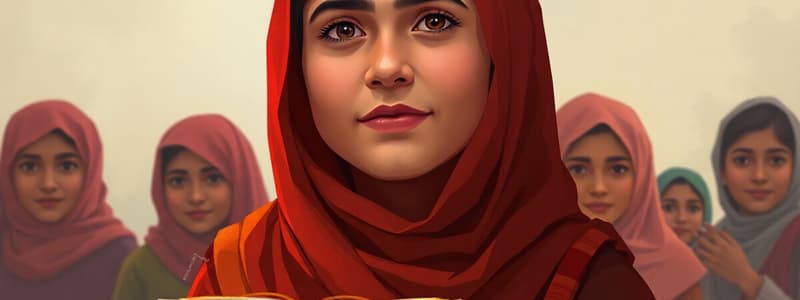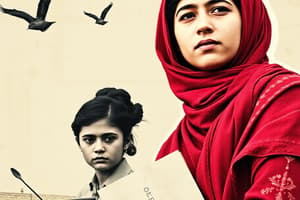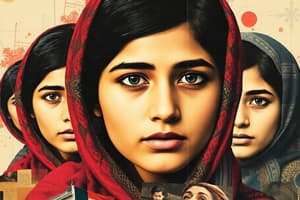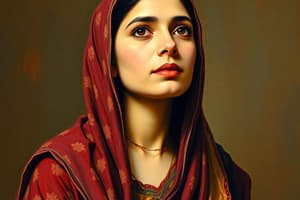Podcast
Questions and Answers
Considering the intricate socio-cultural dynamics prevalent in Mingora as depicted in the excerpt, which assertion most accurately encapsulates the multifaceted responses to Malala's amplified public visibility through media engagements?
Considering the intricate socio-cultural dynamics prevalent in Mingora as depicted in the excerpt, which assertion most accurately encapsulates the multifaceted responses to Malala's amplified public visibility through media engagements?
- While Malala garnered recognition for her articulate advocacy, reactions were significantly polarized, with a notable segment of the community, particularly within her mother's social circle, expressing profound disapproval rooted in entrenched cultural norms regarding female public comportment. (correct)
- The prevailing sentiment in Mingora, even amongst conservative demographics, unequivocally championed Malala's media appearances as a progressive emblem of female empowerment, overshadowing any dissenting voices.
- Criticism directed at Malala's media visibility was primarily confined to overtly extremist factions within Mingora, with the broader populace largely indifferent or passively supportive, thereby minimizing genuine social repercussions.
- The apprehension surrounding Malala's public image stemmed predominantly from pragmatic security concerns, with societal disapproval serving merely as a superficial pretext for deeper anxieties about potential repercussions from extremist elements.
Analyzing Malala's mother's nuanced stance on her daughter's public advocacy, which interpretation most accurately reflects the implicit complexities and potential internal conflict she may have experienced?
Analyzing Malala's mother's nuanced stance on her daughter's public advocacy, which interpretation most accurately reflects the implicit complexities and potential internal conflict she may have experienced?
- Malala's mother, despite potential personal reservations rooted in traditional Pashtun societal norms concerning female modesty, exhibited unwavering and unequivocal endorsement of her daughter's activism in all public and private spheres.
- While outwardly supportive, Malala's mother harbored deep-seated anxieties and fundamental disagreements with her daughter's public persona, primarily due to the intense social censure from her peer group, creating latent familial tension.
- Despite potential personal preferences for a more conventional approach to female propriety, Malala’s mother prioritized familial solidarity and daughterly autonomy, choosing to provide tacit support while navigating external social pressures and criticisms directed at her parenting. (correct)
- Malala's mother's silence and lack of explicit verbal endorsement regarding her daughter's media engagements strongly suggest an implicit disapproval, reflecting a significant divergence in their perspectives on the appropriateness of female public visibility within their cultural context.
Malala's assertion, "Fazlullah's men wear masks...because they are criminals. But I have nothing to hide, and I have done nothing wrong," posits a dichotomy rooted in contrasting ethical and epistemological foundations. Which philosophical framework most accurately elucidates the core of this distinction?
Malala's assertion, "Fazlullah's men wear masks...because they are criminals. But I have nothing to hide, and I have done nothing wrong," posits a dichotomy rooted in contrasting ethical and epistemological foundations. Which philosophical framework most accurately elucidates the core of this distinction?
- Kantian deontology, where Malala's transparency embodies the categorical imperative of acting openly and truthfully as a universalizable maxim, contrasted with the masked figures whose actions inherently violate this imperative through deception. (correct)
- Existentialist ethics, wherein Malala's unveiled face symbolizes authentic self-expression and the acceptance of radical freedom, while the masks represent the inauthentic concealment of self inherent in criminal action.
- Social contract theory, where Malala's unveiling represents her adherence to the implicit contract of societal transparency and accountability, while the masked criminals operate outside and against this contract by concealing their identities from the collective.
- Virtue ethics, emphasizing the cultivation of moral character; Malala's open face manifests virtues of honesty and courage, whereas the masks signify a deficiency in moral character associated with criminality and shame.
The textual juxtaposition of Malala's unveiled countenance with the masked visages of Fazlullah's adherents serves as a potent symbolic device. Beyond the immediately apparent contrast, what deeper, more nuanced semiotic significance can be most rigorously inferred from this deliberate antithesis within the narrative?
The textual juxtaposition of Malala's unveiled countenance with the masked visages of Fazlullah's adherents serves as a potent symbolic device. Beyond the immediately apparent contrast, what deeper, more nuanced semiotic significance can be most rigorously inferred from this deliberate antithesis within the narrative?
Envision a scenario where Malala, facing escalating threats and societal pressures, contemplates adopting a nom de plume and employing strategic veiling (partial niqab) for future media appearances to mitigate immediate risks without entirely ceasing her advocacy. From her explicitly articulated principles and motivations within the excerpt, which course of action would most likely align with her core convictions?
Envision a scenario where Malala, facing escalating threats and societal pressures, contemplates adopting a nom de plume and employing strategic veiling (partial niqab) for future media appearances to mitigate immediate risks without entirely ceasing her advocacy. From her explicitly articulated principles and motivations within the excerpt, which course of action would most likely align with her core convictions?
Flashcards
Malala's Public Identity
Malala's Public Identity
Malala embraced her public persona to advocate for girls' education.
Cultural Expectations
Cultural Expectations
Malala faced pressure to conform to traditional norms regarding modesty.
Support from Family
Support from Family
Malala's mother silently supported her despite societal criticism.
Pride in Advocacy
Pride in Advocacy
Signup and view all the flashcards
Courage Against Oppression
Courage Against Oppression
Signup and view all the flashcards
Study Notes
Malala's Experience
- Malala's best friend, Moniba, became angry when she confessed a secret
- Malala's father revealed a secret to a reporter, describing the terrifying walk to school
- Her father's phone call stating a man threatened to kill her daughter
- The story resonated with others, and journalists followed the issues with the girls' schools
- The diary and journalist efforts to expose issues in Pakistan impacted others
- People in Mingora supported Malala's work, but some criticized her
- Some people thought Malala should have worn a veil
- Her mother supported her, and the criticism made Malala stand firm
- Malala's friends question why she revealed her identity. She believes it's important to do so as a voice for girls' education.
Studying That Suits You
Use AI to generate personalized quizzes and flashcards to suit your learning preferences.
Description
Explore Malala Yousafzai's journey, including her advocacy for girls' education and the criticism she faced. Learn about her decision to reveal her identity and the impact of her work in Mingora and beyond. Discover the challenges and support she received from family, friends, and the community.




